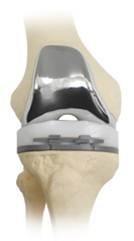
What is a total knee replacement?
A total knee replacement is not really a replacement, it is more of a resurfacing of the knee. The end of the thigh bone is shaved off and a metal cap is put in its place, held onto the bone with cement. The top of the shin bone (tibia) is shaved off and a metal tray is placed, held onto the bone with cement. A plastic (polyethylene) liner is snapped into the metal tray. The metal cap articulates with the plastic liner. A portion of the knee cap is shaved off and replaced with a plastic button.
The new knee is designed to bend a in most cases patients regain the amount of bend they had prior to surgery and may even end up with a little more motion. It is not always possible to improve the amount of bend and sometimes may actually lose a little bit of motion if there is a lot of scar tissue.
When are you ready for a knee replacement?
When the pain or stiffness becomes severe and you lose the ability to perform normal daily activities such as going on walks, going to the store or getting in/out of the car. People may also notice difficulty with other types of activities such as golfing, playing tennis, riding a bicycle or going on hikes. Most patients have tried over the counter medications, a cortisone injection or hyaluronic acid injections. The "need" for a knee replacement goes beyond the xray and just because your xray may show arthritis, you may not "need" one until your quality of life is diminished. Patients usually know when they are ready for a knee replacement.
What is a minimally invasive knee replacement?
Minimally invasive surgery is a buzz-word used in orthopedic surgery used to convey the concept of doing the same surgery through a smaller incision. The real goal is to disrupt less tissue while doing the surgery, thus causing less pain and scar tissue formation after surgery. This may lead to a quicker recovery and may improve the final outcome such as range of motion. While we do perform minimally invasive knee replacement surgery, more goes into it than simply a small incision.
What is Rapid Recovery Joint Replacement?
1. Educating the patient prior to surgery
2. Preoperative physical therapy consultation
3. Coordinating a team focused on the care of a joint replacement patient
4. Minimally invasive surgery
5. Effective pain control that decreases pain while avoiding nausea/vomiting
6. Early postoperative physical therapy
7. Clinical pathways that help standardize the postoperative experience
8. Efficient discharge/home care planning
We are dedicated to making your joint replacement experience the best it can be!
How long will my knee replacement last?
* Most will last more than 15 years
* Some may start to wear out in 10-12 years
* When the plastic wears out, we can change the plastic liner
* Sometimes we have to change the metals parts as well
* We recommend periodic evaluations/xrays starting 10-12 years after surgery
There are other reasons that a knee replacement may need to be redone, such as loosening of the metal parts, infection, continued pain or instability/giving way of the knee. We are highly trained and have significant experience with these complicated surgeries.





